Saving the founder: QE 450th anniversary competition winners enjoy rare chance to see National Archives treasure
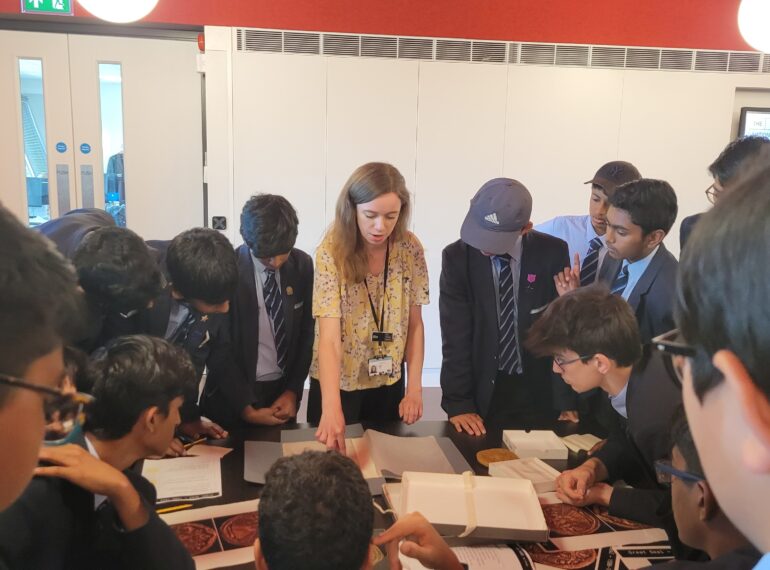
Twenty-three boys whose work was chosen as the best in the QE 450th anniversary research project were treated to a rare look at one of the nation’s most treasured documents on a trip to the National Archives.
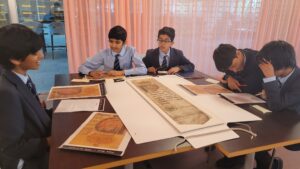 Among the artefacts viewed by the group during their visit to Kew was the actual letter – known as the ‘Tide Letter’ – written by the future Queen Elizabeth I, founder of Queen Elizabeth’s School, as she battled for survival following her arrest in 1554.
Among the artefacts viewed by the group during their visit to Kew was the actual letter – known as the ‘Tide Letter’ – written by the future Queen Elizabeth I, founder of Queen Elizabeth’s School, as she battled for survival following her arrest in 1554.
Jenni Blackford, Curator of QE Collections and Head of Library Services, said: “It was amazing to see such fabulous documents close up and it was a testament to our students’ conduct, interest and behaviour that they brought the Tide Letter out to show them at the end of the session.”
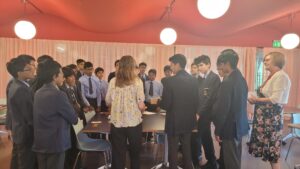 The visit was a reward for the boys who submitted the best entries to Project 1573. This involved small groups of boys being given three primary sources relating to a particular aspect of QE’s history and then asked to produce a three-minute presentation after accessing QE Collections – the School’s online archive – and other archival materials.
The visit was a reward for the boys who submitted the best entries to Project 1573. This involved small groups of boys being given three primary sources relating to a particular aspect of QE’s history and then asked to produce a three-minute presentation after accessing QE Collections – the School’s online archive – and other archival materials.
The winners were:
- Navieeneish Kirubaharan, Param Kapadia, Aarnav Mahajan and Advay Zore, all from Year 8 Pearce form, who researched Timothy Edwards, Headmaster 1961–1983
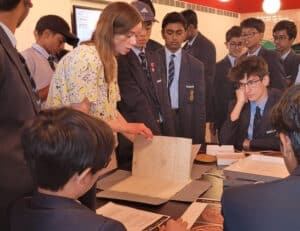 Kelvin Chen, Ethan Yao, Jonas Dawit and Rishi Sen, also of Year 8 Pearce, researching E W Harrison, a long-serving teacher who retired in 1950 and is one of the two unrelated people after whom the Harrisons’ House is named
Kelvin Chen, Ethan Yao, Jonas Dawit and Rishi Sen, also of Year 8 Pearce, researching E W Harrison, a long-serving teacher who retired in 1950 and is one of the two unrelated people after whom the Harrisons’ House is named- Shravanth Sadheesh, Pranav Nayak, Arya Ratnakaram and Sriram Muthukumaran, from Year 8, Stapylton, who looked into QE’s 350th anniversary celebrations in 1923
- Snehal Das, Samir Cheema and Ozgan Cakir, of Year 9, Stapylton, who researched QE becoming a grant-maintained school in 1989, giving it new freedoms to govern its own affairs
- Keeyan Shah, Alex Stack, Shlok Gajjar and Pranith Turaga, also of Year 9, Stapylton, looked into the foundation of the School
- Aahan Shah, Abhinav Sandeep, Jack Tan and Tunishq Mitra, of the Year 9 Broughton form, who investigated the history of Eton Fives at the School.
They saw the Tide Letter, which was written by Elizabeth to her half-sister, Queen Mary I, when the princess was arrested following Wyatt’s Rebellion, an attempt to overthrow the queen, in 1554. Mary gave orders for Elizabeth to be taken to the Tower of London.
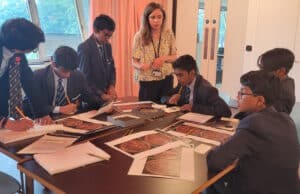 “The students were able to see the neat handwriting at the start of the letter become larger and messier as she was likely made to hurry by those waiting to escort her to the Tower. Fearing her enemies might alter the letter, Elizabeth struck lines through the blank space above her signature,” said Mrs Blackford.
“The students were able to see the neat handwriting at the start of the letter become larger and messier as she was likely made to hurry by those waiting to escort her to the Tower. Fearing her enemies might alter the letter, Elizabeth struck lines through the blank space above her signature,” said Mrs Blackford.
“It is called the Tide Letter because it is believed Elizabeth deliberately wrote the letter to buy time so that the daylight low tide that enabled boats to pass safely through the narrow arches of London Bridge would have turned and she would avoid being taken to the Tower for an additional day.”
Eloquently protesting her innocence, the future queen finishes the letter: “Your hignes most faithful subject that hathe bine from the beginninge, and wylbe to my ende. Elizabeth.”
Her stratagem was successful: she was not taken to the Tower until the following day. Elizabeth was eventually released and then succeeded to the throne on Mary’s death four years later, in 1558.
The Year 8 and Year 9 boys saw a variety of later documents from Elizabeth’s reign, including letters, speeches, Plea Rolls (parchment court records) and the queen’s second Great Seal.
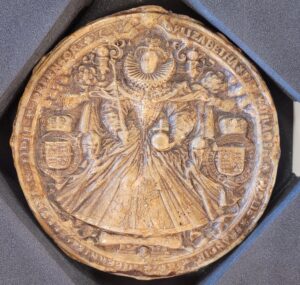 QE’s founding Royal Charter of 1573 was authorised with Queen Elizabeth’s first seal. This, however, wore out during her long reign, and, Ms Blackford said, the boys enjoyed finding out about its replacement: “It is noticeably more elaborate, as Elizabeth had started to closely monitor her image.”
QE’s founding Royal Charter of 1573 was authorised with Queen Elizabeth’s first seal. This, however, wore out during her long reign, and, Ms Blackford said, the boys enjoyed finding out about its replacement: “It is noticeably more elaborate, as Elizabeth had started to closely monitor her image.”
The boys also learned about how the National Archives came into existence, hearing how in the 1830s, civil servant Henry Cole submitted to the Government a dead mummified rat with a stomach full of chewed documents among his evidence of the unsuitability of the premises where public records were then being stored.
